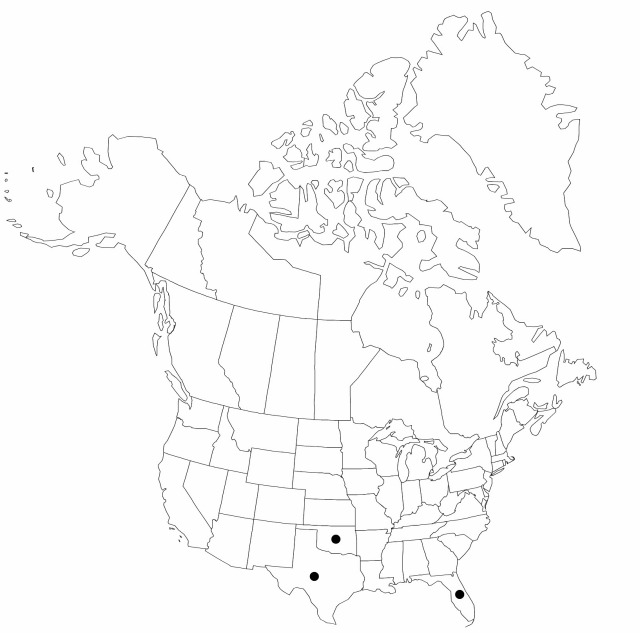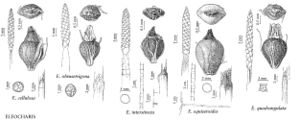Difference between revisions of "Eleocharis interstincta"
in J. J. Roemer et al., Syst. Veg. 2: 149. 1817.
FNA>Volume Importer |
imported>Volume Importer |
||
| (6 intermediate revisions by 2 users not shown) | |||
| Line 1: | Line 1: | ||
{{Treatment/ID | {{Treatment/ID | ||
|accepted_name=Eleocharis interstincta | |accepted_name=Eleocharis interstincta | ||
| − | |accepted_authority=(Vahl) Roemer & Schultes | + | |accepted_authority=(Vahl) Roemer & Schultes |
|publications={{Treatment/Publication | |publications={{Treatment/Publication | ||
|title=in J. J. Roemer et al., Syst. Veg. | |title=in J. J. Roemer et al., Syst. Veg. | ||
| Line 7: | Line 7: | ||
|year=1817 | |year=1817 | ||
}} | }} | ||
| − | |basionyms={{Treatment/ID/ | + | |special_status={{Treatment/ID/Special_status |
| + | |code=F | ||
| + | |label=Illustrated | ||
| + | }} | ||
| + | |basionyms={{Treatment/ID/Basionym | ||
|name=Scirpus interstinctus | |name=Scirpus interstinctus | ||
|authority=Vahl | |authority=Vahl | ||
| + | |rank=species | ||
| + | |publication_title=Enum. Pl. | ||
| + | |publication_place=2: 251. 1805 | ||
}} | }} | ||
|synonyms= | |synonyms= | ||
| Line 26: | Line 33: | ||
|elevation=10–500 m | |elevation=10–500 m | ||
|distribution=Fla.;Okla.;Tex.;Mexico;Central America;e South America. | |distribution=Fla.;Okla.;Tex.;Mexico;Central America;e South America. | ||
| − | |discussion=<p>Contrary to statements in the literature, sectioning reveals that the culm septa are closer together near the spikelet than in the rest of the culm in both Eleocharis interstincta and E. equisetoides.</p> | + | |discussion=<p>Contrary to statements in the literature, sectioning reveals that the culm septa are closer together near the spikelet than in the rest of the culm in both <i>Eleocharis interstincta</i> and <i>E. equisetoides</i>.</p> |
|tables= | |tables= | ||
|references= | |references= | ||
| Line 35: | Line 42: | ||
-->{{#Taxon: | -->{{#Taxon: | ||
name=Eleocharis interstincta | name=Eleocharis interstincta | ||
| − | + | |authority=(Vahl) Roemer & Schultes | |
| − | |authority=(Vahl) Roemer & Schultes | ||
|rank=species | |rank=species | ||
|parent rank=subgenus | |parent rank=subgenus | ||
| Line 49: | Line 55: | ||
|publication title=in J. J. Roemer et al., Syst. Veg. | |publication title=in J. J. Roemer et al., Syst. Veg. | ||
|publication year=1817 | |publication year=1817 | ||
| − | |special status= | + | |special status=Illustrated |
| − | |source xml=https:// | + | |source xml=https://bitbucket.org/aafc-mbb/fna-data-curation/src/2e0870ddd59836b60bcf96646a41e87ea5a5943a/coarse_grained_fna_xml/V23/V23_181.xml |
|genus=Eleocharis | |genus=Eleocharis | ||
|subgenus=Eleocharis subg. Limnochloa | |subgenus=Eleocharis subg. Limnochloa | ||
Latest revision as of 20:39, 5 November 2020
Plants perennial; rhizomes 2–4 mm thick, firm, longer internodes 3–7.5 cm, scales 5 mm, tubers absent. Culms terete, 45–100 cm × (3.2–)5–9.4 mm, soft to firm, sometimes septate-nodulose proximally, not distally, internally hollow with complete transverse septa, closer together near the spikelet, evident externally; plants never forming filiform, flaccid culms. Leaves: distal leaf sheaths persistent, membranous to thinly papery, apex acute to acuminate. Spikelets not proliferous, (20–)40–62 × 4–7 mm; rachilla joints bearing prominent wing-like remnants of floral scales; proximal scale empty, amplexicaulous, (3–)3.5–5 mm; floral scales 115–220, 1–3 per mm of rachilla, stramineous to pale brown, usually with pale to dark brown submarginal band, midrib region sometimes greenish, obovate to broadly oblong, (4–)4.5–5 × 2.8–4 mm, cartilaginous, often membranous toward margins, margins broadly translucent, membranous, apex rounded to subacute. Flowers: perianth bristles 6–8, stramineous, stout, flattened, subequal, exceeding achene, to 2.9 mm, coarsely spinulose; anthers stramineous to reddish, 2.5–5 mm; styles 2-fid or 3-fid. Achenes stramineous to golden-yellow or reddish brown or gray, obovoid to obpyriform, biconvex or nearly plano-convex, often with abaxial longitudinal ridge, 1.4–1.8(–2) × 1.1–1.4 mm, markedly sculptured at 10–15X, each face with 23–37 rows of transversely elongated cells, the longitudinal walls separating the cells often prominent, apex with short neck 0.7–0.8 mm wide. Tubercles dark brown, lamelliform, slightly higher than wide, 0.7–1.1 × 0.5–0.7 mm.
Phenology: Fruiting late spring–winter.
Habitat: Fresh ponds, lakeshores, marshes, springs, ditches, canals
Elevation: 10–500 m
Distribution

Fla., Okla., Tex., Mexico, Central America, e South America.
Discussion
Contrary to statements in the literature, sectioning reveals that the culm septa are closer together near the spikelet than in the rest of the culm in both Eleocharis interstincta and E. equisetoides.
Selected References
None.
